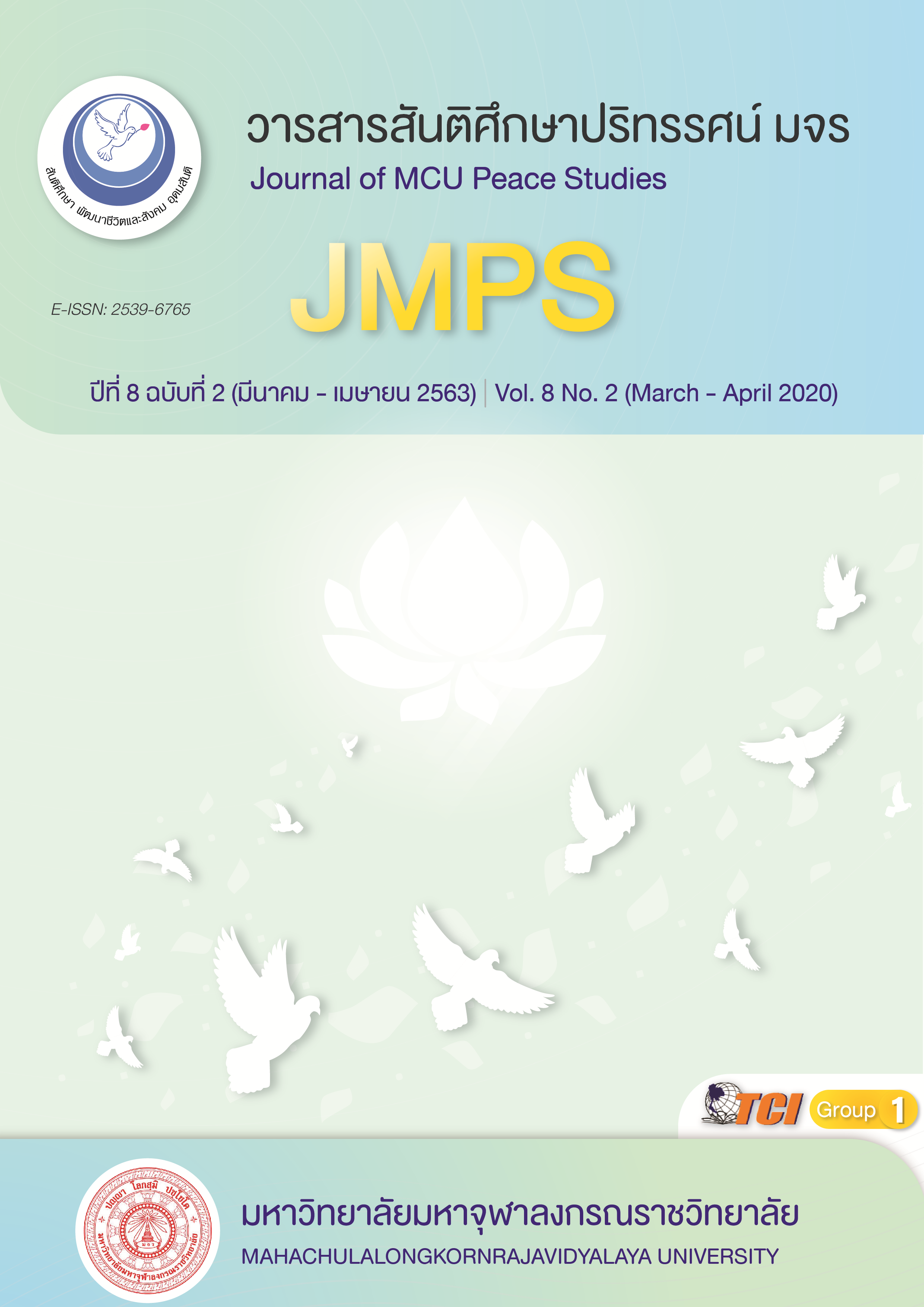ผลของการสวดมนต์และการฟังบทสวดมนต์ที่มีต่อความวิตกกังวลในการสอบของนักเรียนมัธยมศึกษาปีที่ 4 ที่มีความศรัทธาในพุทธศาสนา
Main Article Content
บทคัดย่อ
บทความวิจัยนี้มีวัตถุประสงค์เพื่อ 1) ศึกษาผลของการสวดมนต์และการฟังบทสวดมนต์ที่มีต่อความวิตกกังวลในการสอบของนักเรียน ที่มีความศรัทธาในพุทธศาสนาต่างกัน 2) เปรียบเทียบผลของการสวดมนต์และการฟังบทสวดมนต์ที่มีต่อความวิตกกังวลในการสอบของนักเรียน ที่มีความศรัทธาในพุทธศาสนาต่างกัน
เป็นการวิจัยแบบกึ่งทดลอง แบบ 2x2x3 Design with One Factor Repeated Measure การวิเคราะห์ข้อมูลด้วย 3 Way ANOVA with Repeated Measure
ผลการศึกษา พบว่า กลุ่มสวดมนต์ไม่ว่าจะมีศรัทธาในพุทธศาสนาสูงหรือมีศรัทธาในพุทธศาสนาต่ำจะมีความวิตกกังวลในการสอบ ลดลงได้มากกว่า กลุ่มฟังบทสวดมนต์ และกลุ่มควบคุม มีความแตกต่างอย่างมีนัยสำคัญทางค่าสถิติอยู่ที่ .01 ความวิตกกังวลในการสอบเกิดจากกระบวนการคิดที่เชื่อมโยงระหว่างภาวะความวิตกกังวลกับสถานการณ์สอบ ก่อให้เกิดความไม่สบายใจต่อบุคคล วิธีการจัดการกับความวิตกกังวล
คือ การผ่อนคลาย คือการสวดมนต์ เพื่อให้จิตเกิดเป็นสมาธิ และสติ มีความสงบ ผ่อนคลาย และการทำซ้ำๆ เป็นระยะเวลาที่ต่อเนื่อง สามารถอยู่กับปัจจุบันขณะ ไม่ตีความสิ่งเร้าที่เข้ามา เมื่อเจอกับเหตุการณ์
จะสามารถควบคุมอารมณ์ของตนเองได้ ยอมรับสถานการณ์ ความรู้สึกของเราก็จะดีขึ้น ผ่อนคลายความวิตกกังวลในการสอบได้
Article Details
ทัศนะและความคิดเห็นที่ปรากฏในบทความในวารสาร ถือเป็นความรับผิดชอบของผู้เขียนบทความนั้น และไม่ถือเป็นทัศนะและความรับผิดชอบของกองบรรณาธิการ ยินยอมว่าบทความเป็นลิขสิทธิ์ของวารสาร
เอกสารอ้างอิง
Akinsola, E, F., & Nwajei, A. D. (2013). Depression and Academic Performance: Assessment and Management Using Relaxation and Cognitive Restructuring Techniques. Psychology, 4(6), 18.
Akinson, R. C., & Shiffrin, R. M. (1968). Human memory: A proposed system and its control processes, In K. Spence & J. Spence (Eds.). The Psychology of Learning and Motivation. 2. New York: Academic Press.
Brown, R. P. (2003). Measuring Individual Differences in the Tendency to Forgive: Construct Validity and Links with Depression. Personality & Social Psychology Bulletin, 29(6), 759.
Buzan, T. (1995). Use your Head. London: BBC. Books.
Chanpo, K. (2013). Effects of Buddhism Pray and Anapanasati Meditation on Stress in Chulalongkorn University Students. (Master's Thesis). Chulalongkorn University. Bangkok.
Chareanphon, S. (2014). A Study of the Relationship between some Factors and Learning Adjustment of Secondary Students in the Demonstration School Rajabath Institute in Bangkok Metrololis. (Master's Theis). Srinakharinwirot University. Bangkok.
Craske, M.G; Stein, M.B. (2016). Anxiety. Seminar, 388(10063), 3048-3059.
Krohne, H.W., & Laux. (1982). Lothar Achievement Stress and Anxiety. New York: Hemisphere Publishing.
Lazarus, R. S., & Folkman, S. (1984). Stress Appraisal and Coping. New York: Springer Publishing Company.
Nuibandan, A. (2009). The Effect of Prayer on Stress of Nursing Students of Prince of Songkla University. (Master's Thesis). Prince Songkla University. Songkla.
Phatihatakorn, V. (2011).The Effect of Classical Music on Test Performance and Test anxiety of Introverts and Extraverts. Bangkok: Srinakharinwirot University.
Phongwan, V. (2016). Effect of Thai Mantra Meditation on Relaxation: An EEG Study. (Master's Thesis). Faculty of Psychology: Chulalongkorn University. Bangkok.
Phra Nawleang Tejanyana. (2013). A Comparative Study of Saddhā (Faith) in Theravāda Buddhism and Jainism. (Master's Thesis). Mahachulalongkornrajavidyalaya University. Bangkok.
Puttapitak, P. (2011). The Development of a Clinical Nursing Practice Guideline for Enhancing the Quality of Life of Caregivers Who Cared for the Terminally Ill Cancer Patient in Community. Journal of Food Health and Bioenvironmental Science, 4(1), 39-52.
Sperling, G. (1960). The Information Available in Brief Visual Presentations. Psychological Monographs.
Spielberger, C. D. (1972). Anxity as an Emotional State. In C.D. Spielberger Anxity and Behavior. New York: Academy.
Sung, Y. T., Chao, T. Y., & Tseng, F., L. (2017). Reexamining the Relationship between Test Anxiety and Learning Achievement: An Individual - Differences Perspective.Contemporary Educational Psychology, 46, 241-252.


